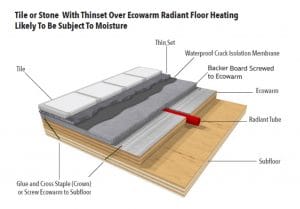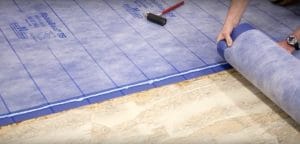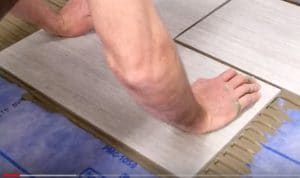Case Study: Commercial Installation of Ecowarm Radiant Floor Heating
For this project contractors installed Ecowarm Radiant Floor Heating into a 2,500 sq ft commercial building in Santa Fe, New Mexico.
For this project contractors installed Ecowarm Radiant Floor Heating into a 2,500 sq ft commercial building in Santa Fe, New Mexico.
For this project Ecowarm Radiant Floor Heating was installed throughout a large family room featuring cathedral ceilings.
This radiant floor heating article is designed to communicate a quality and cost effective method of installing ceramic tile over radiant floor heating board systems. The system shown below is straight forward and avoids using unnecessarily expensive and complex products.
All materials expand and contract at different rates and with tile it is particularly important to accommodate this in a quality installation over radiant heating boards. Radiant floors typically go through a range of floor temperatures depending on the amount of heat loss occurring at the time.
In moderate weather the floor temperature may only be a few degrees hotter than the room temperature but in extreme heat loss conditions it could under certain circumstances be as much as 15°F hotter than the room temperature. The co-efficient of thermal expansion of the radiant board substrata and ceramic tile are not the same. Properly installed tile is very durable but will be prone to cracking if provision is not made to account for the differing expansion of these layers of materials.
By utilizing a flexible crack isolation membrane this challenge can be cost effectively solved and also provide, with proper installation and material choice, protection from moisture getting into the substrata. Since tile is so frequently installed in locations that are prone to moisture such as bathrooms and kitchens this moisture protection is important.

The system described above is the cost effective system that our company recommends for our Ecowarm Radiant Board. But it is generic enough that, with small common sense changes should be applicable to most infloor radiant board systems.
In the drawing the radiant board is attached to the subfloor using, preferably, a low VOV green construction adhesive glue on the bottom along with screws or cross staples from a sheathing stapler at the eight attachment points. Cross stapling means putting 2 staples at opposing 45 degree angles close to each other. Cross stapling along with the bottom side glue makes for a very secure and squeak resistant installation of the board. The next step is installing cementitious backer board over the radiant board. It may be ¼” .3/8” or ½” depending on the needs of matching other floor heights.
Before installing the backer board a thick sheet of clear plastic should be cut to size of the room or area to be installed with the backer board. Using a permanent marker make a template of where the tubing runs are. The plastic template can be unrolled and used to locate where to snap lines that will locate the tubing to avoid screwing through. Taking photographs of the tubing installation is a good idea also. The backerboard may be installed to the radiant board using modified thin set and screwed to the radiant board.
The hydronic tubing should be under an air pressure test during the installation so that if a puncture occurred it would be found. To date we have not found a modified thin set that is incompatible with the PEX pipe used in the radiant board but it is always good to check with the PEX manufacturer as well. There are other PEX pipe compatible adhesives such as Bostik Greenforce that can be used to adhere backerboard to our radiant board but are more expensive than thin set. Remember all glues take longer to set on aluminum since only one of the two surfaces is absorbent. Once the backerboard is attached to the radiant board, an anti-fracture membrane should be installed over it.
We recommend products from the Noble Corporation http://noblecompany.com since they were early supporters of the radiant floor heating industry and trade groups called and have very radiant savvy tech support people. They make a range of appropriate products but the one we recommend is called Noble Seal TS http://noblecompany.com/products/nobleseal-ts which performs as a crack isolation or antifracture membrane and when properly installed adds water proofing of the substrata. Properly installed and rated in TCNA approved tests as High Performance, it will accommodate up to 1/8” differences in the expansion and contraction of the layers thus preventing cracking of the tile.

Photo courtesy of The Noble Company
The anti-fracture membrane is made from an extruded CPE sheet layer pf polyester fiber bonded to either side. TS may be installed on the cementitious backboard in two ways. The first way is with modified thin set mortar which requires a cure time before the installation of the tile, or in the case of Noble Seal TS there is an adhesive called Nobel Bond EXT that can be used that has enough tack that tile may be installed using modified thin set on it, without the additional cure time. The membrane may be made waterproof by lapping it 2”and using a waterproof sealant such as NobleSealant 150 to bond the overlap.
There are other brands with anti-fracture membranes and a family of related products where the installation would be similar. Lastly, tile is usually thin set to the anti-fracture membrane and after an appropriate drying period grout is applied.

I grew up in a house with an addition with radiant floor heating. My mother was a Frank Lloyd Wright fan and so the new wing on our house had radiant floor heating with tubing in concrete covered with a thin cork floor. Frank Lloyd Wright was an early proponent of radiant floor heating. I remember it was always warm and inviting in the big playroom with radiant heat where we kids always played. Later as a professor at the University of New Mexico in the early 1980s, I met a Norwegian who was promoting and educating people about radiant floor heating. Again I was amazed at how comfortable it was. This time I also wanted to understand the thermodynamics of how it worked and all the ways it could be installed. Thus began my now 36 year involvement with radiant floor heating.

Ecowarm RadiantBoard is a product of WBI. Warm Brothers Incorporated (WBI) was founded in the year 2000 with the granting of patent 22323 for radiant panels systems.
The company has been offering several radiant panel designs under different patents manufactured in both the Eastern and Western United States under several brand names providing the broadest offering of radiant panel solutions in the industry.
